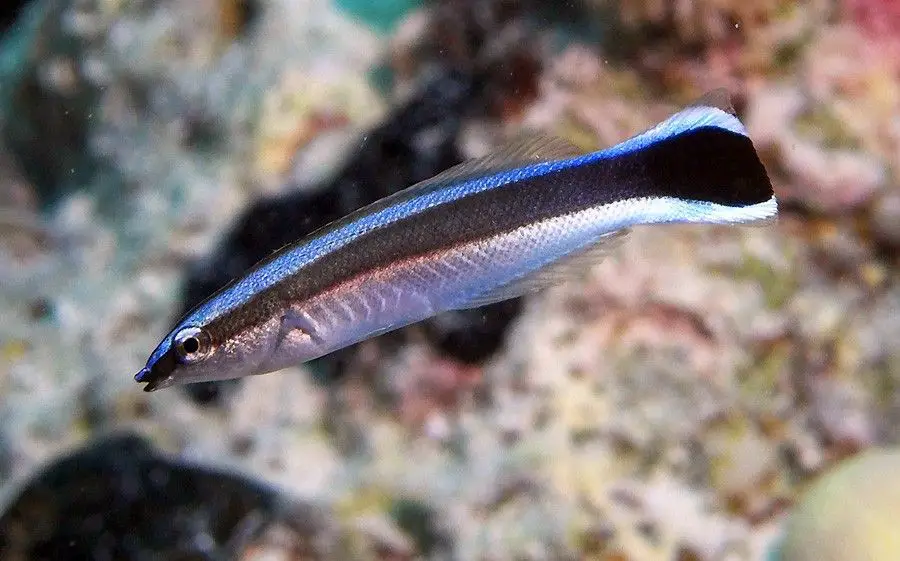Do you have some saltwater fish that need some TLC and a good cleaning? Then you need a cleaner wrasse.
Look no further than the cleaner wrasse- a species of fish that can aid you in cleaning your tank and provide you with an eye-catching new addition to your aquarium community.
These amazing fish remove and eat parasites from your fish and also remove dead and decaying scales from the fish in your tank helping to keep your tank healthy and parasite free!
Table of Contents
Cleaner Wrasse: Species Profile
| Scientific Name | Labroides dimidiatus |
|---|---|
| Care Level | Moderate-Difficult ( Feeding) |
| Temperament | Peaceful |
| Color | Black,Blue,Silver,White |
| Origin | Eastern Africa, Red Sea,Maldives |
| Family | Labridae |
| Size | 5-6” Max |
| Tank Size | 50 Gal+ Minimum |
| Reef Compatible | Yes |
| Diet | Carnivore |
| Price | $20-$40 |
| Water Quality | 72-78f pH 8.1-8.4 dKH 8-12 sg 1.020-1.025 |
In total, there are 5 unique species of cleaner wrasse: Bluestreak cleaner wrasse (labroides dimidiatus), black spot cleaner wrasse labroides pectoralis), Hawaiian cleaner wrasse (labroides phthirophagus), bicolor cleaner wrasse (labroides bicolor), and red lip cleaner wrasse (labroides rubrolabiatus).
Cleaner wrasses, particularly the Bluestreak wrasse, are popular choices for reef aquariums as they are known for their natural instinct to clean. In their natural habitat, wrasses will choose a location and make it into a home.
The wrasse will then rid the nearby fish and other sea creatures of parasites, dead skin and scales, and mucus. The wrasse might even go as far as to clean the inside of its client’s mouth and gills.
In areas of the ocean that lack cleaner wrasses, it has been found that the fish populations were 37% less abundant as well as 23% less diverse than their wrasse-dwelling counterparts.
Wrasses are pleasing to look at as they swim around your aquarium. They are long, slender fish that have pointy noses. They can grow to be anywhere from 3 ½-inches to 5.9-inches, long. Despite being divided into specific species, all cleaning wrasses share protruding teeth that resemble tweezers which allow them to pluck parasites and debris from other fishes’ bodies.
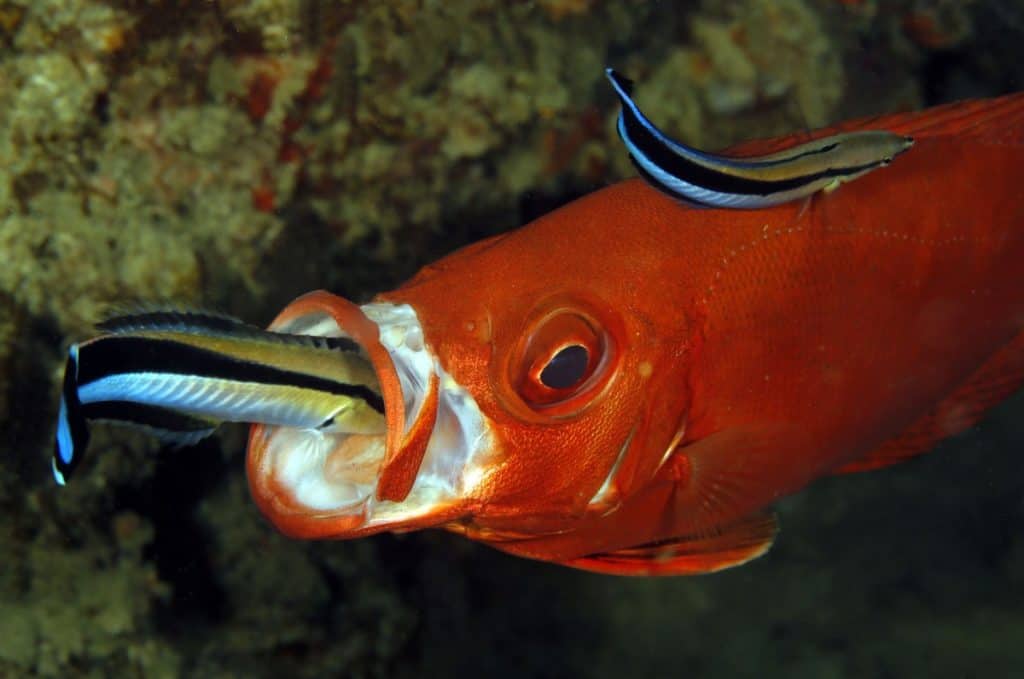
Should you quarantine new cleaner wrasse?
Although cleaner wrasses can be difficult to take care of, they are a very rewarding fish to have in your aquarium. If you know how to care for you wrasse you shouldn’t have too many problems and will be able to enjoy your friendly fish for a long time. In fact, cleaner wrasses that are kept under the proper conditions can live up to 10 years in captivity.
When purchasing a cleaner wrasse you need to be careful not to introduce disease into your tank. Many stores will use cleaner wrasse to rid their infected tanks from diseases and parasites. However, buying a cleaner wrasse that has been used in this way could result in the condition being transferred to your tank.
Make sure like any other saltwater fish that you buy wisely and quarantine in the normal way. There care level is classed as high due to their diet. If you have a large well-stocked aquarium these fish will give you hours of fun watching them take care of the other fish.
Where do Cleaner Wrasse come from?
These fish are found on coral reefs from Eastern Africa and the Red Sea to French Polynesia. They are found in a group of different cleaner wrasse called Cleaning stations. These groups normally consist of Young cleaner wrasse, a grown-up pair or a group of females with a dominant male.
When a client fish as they are known swims into the cleaning station they are welcomed with a special dance, where they move their rear up and down to attract a fish to clean. The better the dance the more chance the fish will let them clean it.
Remember the cleaner wrasse clean fish so that they get fed. It’s a win-win situation for everyone involved. The Bluestreak cleaner wrasses clean to consume ectoparasites .
When a client is happy to let the cleaner wrasse clean them and eat all the ectoparasites they adopt a pose that lets the cleaner wrasse know to begin the cleaning process. This position differs from species to species.
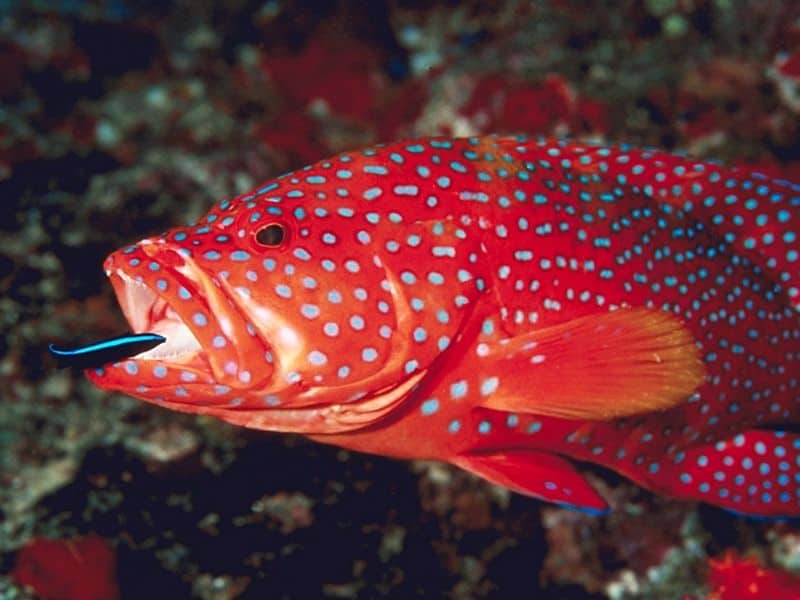
Cleaner wrasses need plenty of space to swim and an abundance of rocks to swim through and hide in. It’s important to add plenty of large rocks to your aquarium because rocks are essential to your wrasses “business”- that is, his instinct to clean other fish.
Cleaner Wrasse tank size
Your wrasse will choose a rock to use as his designated cleaning station and service his clients in your tank. Here, the cleaner wrasse will get to work inviting clients by making a calming motion with his or her tail.
Wrasse tanks should also have a bed of sand instead of rock because they are known to bury themselves in the sand at night and rocks could prove to be dangerous. Cleaner wrasses do well in tanks with coral, as they won’t nip at or teal the coral’s food.
Cleaner wrasses should always be kept with multiple tank mates. This is because cleaner wrasses live most of their lives trying to clean other fish and this is unable to happen if they live alone or with very few other fish.
Any tank that is to be used to house a cleaner wrasse should have a tight-fitting lid and feature safety grates or coverings over any openings in the tank’s filtration system. Due to the frequency of the cleaner wrasse’s cleanings, its tank mates may become agitated and chase the wrasse, causing it to jump and either jump out of the aquarium or become injured on a tank accessory.
A tank for a cleaner wrasse should be at least 50 gallons, but ideally, they should be housed in tanks 135 gallons or more. The water temperature should sit between 71 to 78 degrees Fahrenheit and water changes should be done frequently.
What do Cleaner Wrasse eat?
Most cleaner wrasse owners find that feeding this type of fish is the hardest part of caring for it. Due to their small, slender bodies, they aren’t built to store food the way that other fish are, causing them to need to eat frequently during a 24-hour period.
Cleaner wrasses benefit from eating seaweed sheets. Seaweed isn’t the most nutritious food that the wrasse could be eating but between feedings and at night when food is scarce, seaweed strips prove to be beneficial in providing the wrasse with a satisfied tummy.
Bluestreak Cleaner Wrasse must be fed small quantities of fresh, meaty foods multiple times per day as they can’t eat too much at once. Try frozen brine shrimp, and other smaller, meaty foods. Once your cleaner fish is fully adjusted to your aquarium then try offering them a good quality marine flake like TetraMarine Flakes from Chewy.com and small marine pellet foods like Omega Garlic Pellets packed with nutrition to complement their staple diet of enriched frozen food.
Keeping large fish or large numbers of fish in a wrasse tank provides the wrasse with an adequate supply of food, whereas too few fish or too small of fish can cause the wrasse to become hungry. In general, wrasses do better in larger community aquariums where they have plenty of returning clients.
Can you keep two cleaner wrasse together and will the breed?
Wrasses have been known to reproduce in captivity, however, more of the offspring parish than survive.
Breeding usually kicks off at twilight and once female wrasse eggs have been released into the water. This only happens after the male wrasse attracts multiple females to his area of the tank or ocean (known as a “territory”). Once fertilized, the eggs form planktonic larvae and move alongside the currents.
If the male of the territory dies or otherwise leaves, the most dominant female will take his place. She will then become male within 24 hours and proceed to mate with the rest of the females in the area, populating the territory further.
It has to be said that there are very few occasions of these fish breeding in a small home aquarium.
How to sex Cleaner Wrasse
Unfortunately, it’s nearly impossible to sex cleaner wrasse. Telling males and female apart is very difficult if not impossible. Male wrasses, however. Are thought to be larger than females, but when witnessing mating pairs, it’s hard to distinguish between the two as both look very similar.
Sex change from female to male can take place in the absence of a dominant male cleaner wrasse, as well as after the death of the head wrasse. If a female is to turn into a male, she will usually do so before she turns 3 years old.
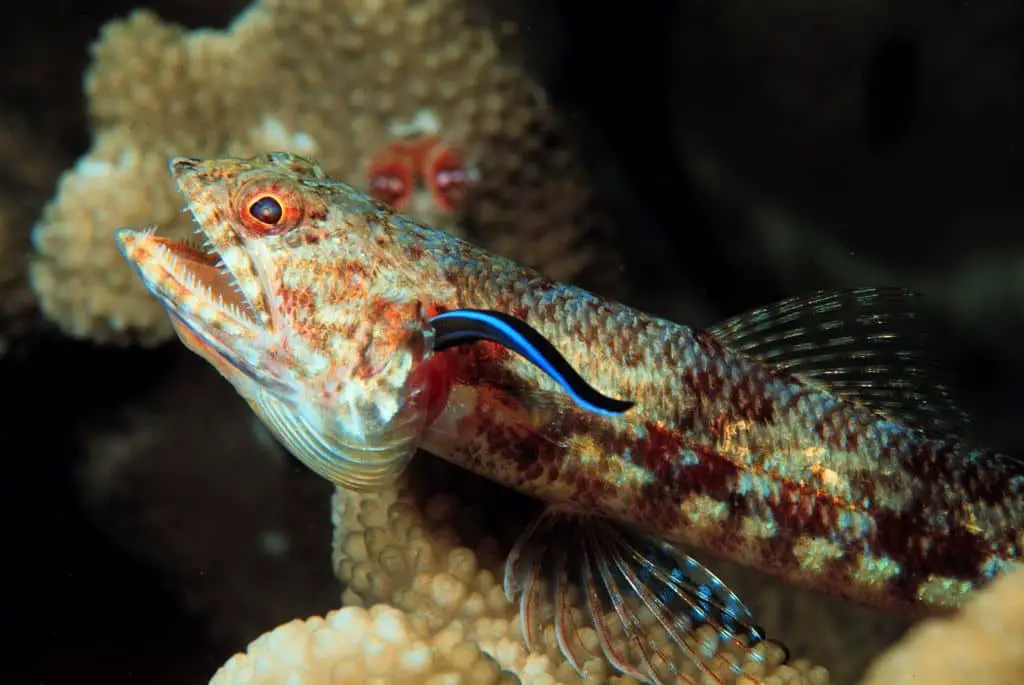
Tank mate to avoid
Cleaner wrasses are social fish who get along well with a variety of tank mates, however, there are certain breeds of fish that wrasses do not fair well with. This is usually because the wrasse and the tank mate in question fight for rock space or because the cleaner wrasse are extremely enthusiastic with its cleaning and the other fish is too slow to swim away from it.
Boxfish are often referred to as “trunkfish” or “cowfish”. They grow to be about 3 inches in size in captivity and are recognized by their box-like shape. Their sides are bony and plated, making them susceptible to harm if your cleaner wrasse tries to clean their thin skin.
Pufferfish are known for their ability to blow up into a spiky ball when they are scared, stressed, or being harassed. They do this by taking large amounts of water into their stomachs and using it to blow their bodies up to twice their size.
Because pufferfish are easily distressed, keeping them with overzealous clear wrasses is not the best idea as the wrasse may cause the pufferfish a great amount of stress.
Frogfish, Lizardfish, and Scorpionfish
Frogfish, lizardfish, and scorpionfish have been known to eat cleaner wrasses in captivity, despite cleaner wrasses being a worthy enemy in their natural habitat.
Suitable tank mates
Cleaner wrasses need plenty of fish to service in order to stay fed and healthy. They can’t be kept with every type of fish, but they are relatively peaceful tank mates that can be housed with a variety of fish.
This striking fish has a yellow head, pink-red anterior and a white posterior as well as dorsal, anal, and caudal fins that have thin black highlights. Firefish are even-tempered and full of personality. Firefish live in groups and eat planktonic food out of the water.
They are non-aggressive but can be hostile towards others of their kind. Firefish need a variety of rocks and places to hide as they can be skittish. They also need an aquarium with a tight-fitting lid as they are known to jump.
Firefish has a sale price of around $12-$13.99.
Blennies are also great saltwater fish that have character and love to be cleaned.
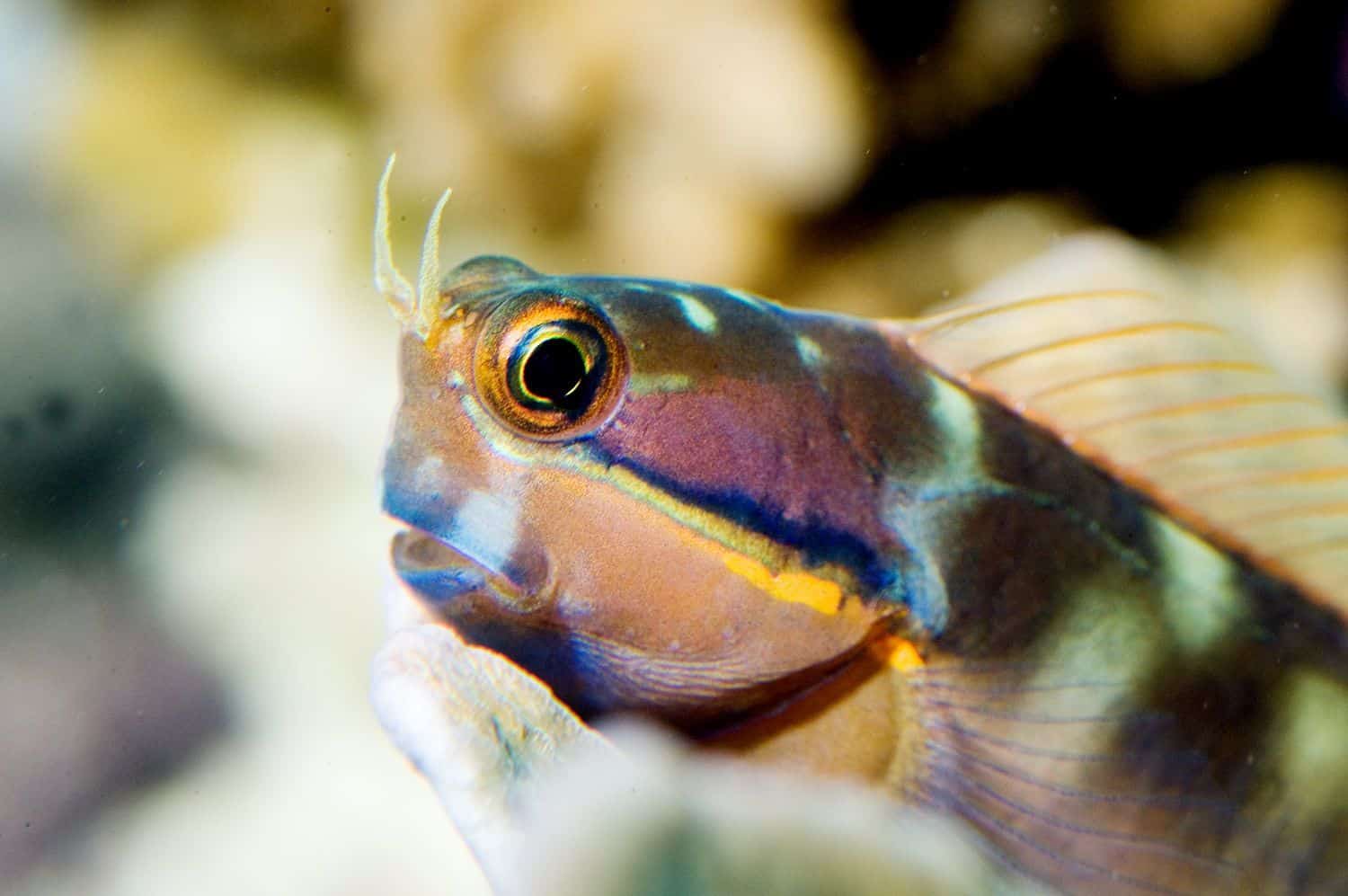
Banggai cardinalfish thrives in small schools or groups and are calm, peaceful fish. They are reef safe and won’t bother corals, clams, or invertebrates. They are a mouthbrooder species, with the male able to house up to 25 fry in his mouth for 5 weeks.
Banggai cardinalfish re easily distinguished by their striking color pattern- three black bars spanning the head and body, black edges on a variety of fins, and black pelvic fins that have white spots, with similar white spots running along a few fins.
These fish sells for $20-$23.00
Nearly teardrop-shaped and colored with delicate black markings- both stripes and spots-, the black striped angelfish truly is an angel. The fish is peaceful in temperament and gets along well with other peaceful reef fish.
They spend their time floating in open waters to catch floating invertebrates. Black striped angelfish can be shy and need plenty of rock formations in which to hide and to take shelter in at night.
They can be kept in large aquariums in groups that use the ratio of one male to many females. In addition, two females can be kept successfully together, but a pair of two males will fight.
Black striped angelfish can be tricky to find online but may be able to be purchased on websites such as live aquarium.com
Goatfish live in schools and tend to be non-aggressive. There are a variety of goatfish and each has their own colorations, ranging from yellow to red, to blue. Some even have stripes and spots.
Goatfish in captivity can grow to be 12 inches and should be kept in very large tanks to accommodate their schooling nature. They prefer warm, calm water.
This species of fish eat anything from worms to insects and small crustaceans and can be purchased online from $28.99-$49.99.
The gold-spotted rabbitfish has a beautiful golden body and thin blue lines that give off the appearance of spots. They require very large tanks with an abundance of open swimming space.
They are herbivores and should be given a steady diet of algae. They are peaceful fish who keep to themselves and can be housed with peaceful or aggressive fish. They may nip at corals but are otherwise safe for reef tanks.
Rabbitfish can be kept in pairs of the same kind but can become aggressive with other rabbitfish species.
Their online retail price averages $49.99
What to look for when buying a cleaner wrasse
Make sure you buy the correct Cleaner Wrasse. People often mistake The true Bluestreak cleaner wrasse (Labroides dimidiatus) with a similar looking fish the false cleaner wrasse (Aspidontus taeniatus)
This picture shows the difference between the two fish.

Many people look at the colors and the black and blue stripe for the difference. It’s not these two factors that is the way to tell them apart from the position of their mouths.
If you look at the cleaner wrasse, their mouths are positioned centrally at the end of their face. Now look at the false cleaner wrasse and you’ll see their mouth is underneath compared to the true cleaner wrasse.
In an aquarium, the false wrasse can annoy and hurt other fish. They pretend to be cleaning and then nip the poor unsuspecting fish.
Personally, I also think they are not as pretty and colorful, but again that’s not the way to identify them.
Cleaner Wrasse F.A.Q
Q. Can I keep more than one wrasse in an aquarium?
A. It’s a good idea to keep one cleaner wrasse per tank, as they can be very territorial with each other. If you wish to keep more than one, keep male-female pair to increase the chances that the wrasses will get along.
Q.What lighting does a cleaner wrasse need?
A.Cleaner wrasses don’t need any special lighting. They do well in moderate lighting but prefer sunlight. They are a diurnal species and sleep when it gets dark in their tank.
Q.What is the difference between a cleaner wrasse and a “cleaner” benny?
A.The difference is that only the cleaner wrasse truly cleans its clients. The cleaner benny, known as the “false cleaner fish” mimics the job that cleaner wrasses do. It appears to clean its clients, but instead of freeing them of parasites and dead skin, the benny will bite and nip at the clients’ fins and flesh instead.
False cleaner fish not only use their disguise to torment other fish, but also to avoid predators as the cleaner wrasse is loved by many fish for its cleaning services and has few enemies.
Q.How much does a Cleaner Wrasse cost?
A.On average a good quality, Bluestreak Cleaner Wrasse cost anywhere between $20-$40 depending on size and quality.
Cleaner Wrasse Lifespan
The average lifespan of a cleaner wrasse is 3-4 years. Some fish have been reported to live longer but they rarely live longer than 5 years in a home aquarium.
Conclusion: Cleaner Wrasse care guide
Would we recommend you buy a Bluestreak Cleaner Wrasse…. 100% YES!
Like we have mentioned, as long as you have a tank 50Gals or bigger and you have plenty of fish for them to feed off then these colorful and interesting fish make a good addition to your tank.
Without question, the Cleaner wrasse is an affordable and interesting saltwater fish suitable for the home aquarium.
- Green Mandarin Dragonet: Diet | Breeding | Size | Cost |Guide
- Firefish Goby: Diet | Size | Care | Lifespan | Cost
- Cleaner Wrasse: Diet | Size | Breeding | Sexing | Cost
- Best Cleanup Crew For a Reef Tank | Algae | Substrate | Scavengers
- Where Does the Mandarin Fish Live?

I have been working in the tropical fish industry for over 30 years now and I’m still learning. Everyday is a school day in this hobby. In my spare time I play golf very badly!


